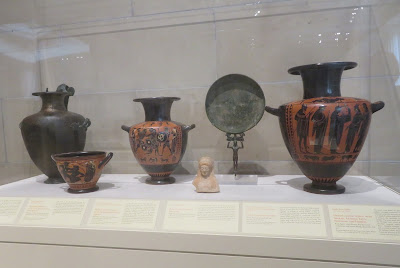Stop two was the Classic Court with art from Western Antiquity, Ancient Egypt through the fall of the Roman Empire. I love this shit, I really do.
Modern man makes art as a celebration of the genius of himself. This trend toward self-reflection grew out of the Renaissance, but it is not present in the same way in the art of other cultures or previous eras. In this case the art of antiquity centered in the Mediterranean and Middle Eastern cultures does celebrate humans, but as an adornment on utilitarian objects. In civic spaces it tells stories and records histories. And nature is just as important as human beings because the two are not see as other. In this paradigm lost, there is an elegance and a purity of purpose that I just find compelling.
If you doubt my thesis, ponder this. Make two T charts and on the top write "Western Modern Art: 1450-Present" and on the other write "Western Art before the Renaissance." Now write the word "Artist" above the left column and the word "Artwork" above the right column of both. Now go for. Name as many of each on either chart. Every knows the artist Picasso. But how many of his works can anyone name?
I present to you highlights.
EGYPTIAN
"Lion," 380 BCE - 50 CE
Egyptian, Late Period, Dynasty 30 - Roman Period
"Heart Scarab of Nesypa," 700-650 BCE
Egyptian, Dynasty 27
"Fragment of a Relief: Portrait head of a Noble," circa 1350 BCE
Egyptian, from the Tomb of Thebes, Dynasty 18
"Set of Canopic Jars," 600 BCE
Egyptian, Dynasty 26
(Human and Baboon)
"Model Boat," n.d.
Egyptian, probably from Meir, Dynasty 11-12
PERSIAN
"Vessel in the form of a Deer," 1000 - 750 BCE
Persian, from rhe region around the town of Amlash
"Fragment of a Winged Deity," 883-859 BCE
Neo-Assyrian, from Kalah (modern Nimrod) Iraq
GREEK
"Plate with Hound," 640-630 BCE
GREEK, from Rhodes
"Olpe (pitcher)," 640-630 BCE
GREEK, from Corinth
"Bust of the Goddess Demeter," 500 - 450 BCE
Greek made in Sicily
"Kylix (Drinking Cup) with Revelers," 490 - 480 BCE
Greek, from Athens
ROMAN
"Venus," 180 - 220 CE
Roman, from Asia Minor
"Portrait of a Young Man in Armor," circa 130 CE
Roman, from Aphrodisias in Asia Minor
"Imago Clipeata (Shield Portrait) of Augustus," 15-30 CE
Roman




















No comments:
Post a Comment